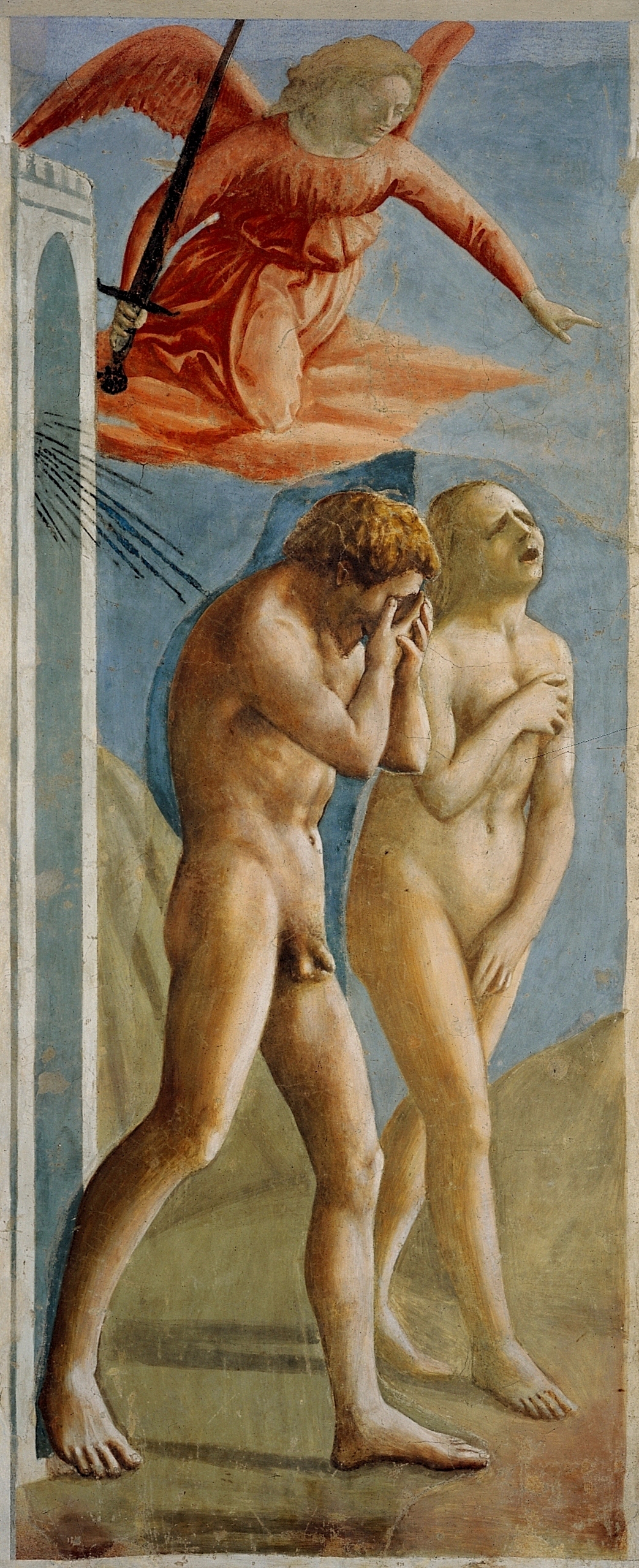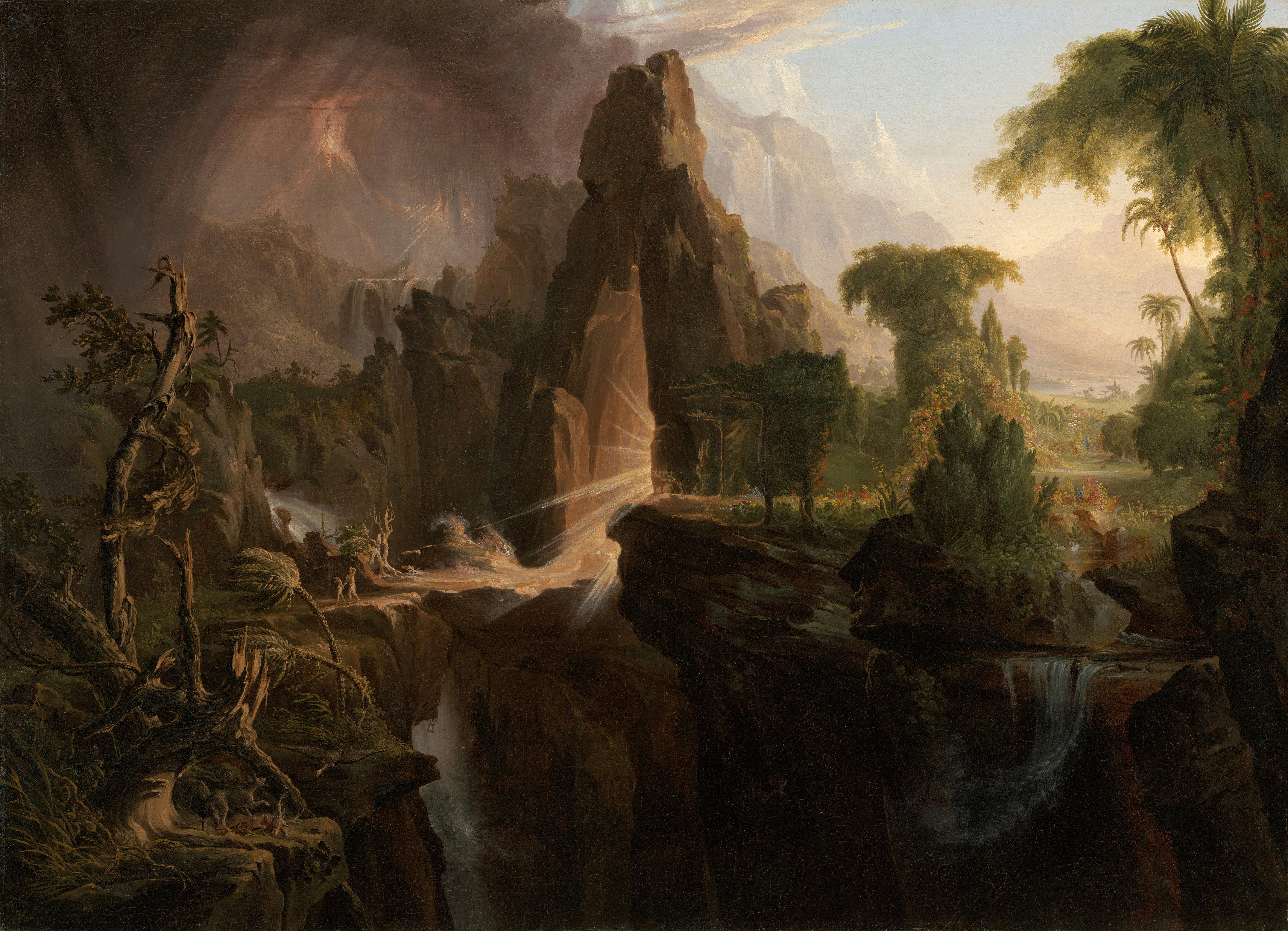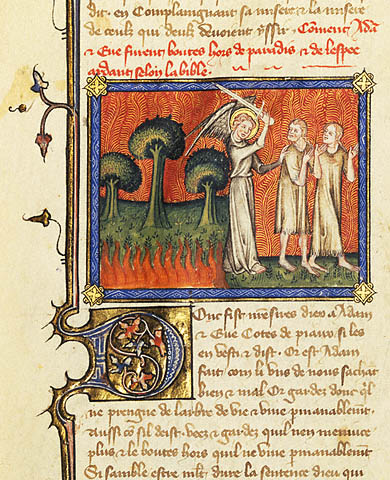The story of the Expulsion from Paradise is widely known, yet the obvious question remains; how do you think the scene appeared? God and his angels banish the pinnacle of God’s creation; Adam and Eve are no longer allowed to remain in the Garden of Eden. The basis is the same; Adam and Eve are expelled form the Garden in each version, but the way it is depicted by every culture is different. Over the span of many centuries and across numerous different cultures there are many different versions of this story.
The pieces chosen for this exhibit exemplify the spectrum of depictions of the Expulsion scene throughout the centuries. These pieces range from oil paintings to ink sketching’s, even the medieval period has painted this scene in their Bible in 1360. These pieces show the different views people, especially the culture of the artists on display, hold about the expulsion of the human race from Paradise, God, and the Garden of Eden itself. Even the purpose of the paintings and sketchings of the Expulsion from Paradise are exponentially dissimilar. This is why it is necessary to see the broad scope of theologies revolving around the Expulsion from Paradise.
This Expulsion scene is the latest in the series, and is also unique because its focus is on the Garden of Eden and not on necessarily the Expulsion of Adam and Eden. The people of the 1800s are more concerned with imagining how the Garden of Eden must have looked then painting the scene that people are extremely familiar with. The culture is focused more on what is unknown. The details are intricate and the colors are far from flat, which creates the mood of somber awe, seeing the minuscule figures exiting this glorious looking place.

The Expulsion from Paradise, Charles Natoire, 1740, oil on copper, 1987.279
This painting by Natoire mirrors slightly the drawing by
Weirix in the way that he also includes certain animals as symbols of
things like sin and lust. He also is influenced by Michelangelo’s work
in the way he represents God. Natoire’s depiction of the scene itself is
also not biblically accurate, although it is certainly Religious.
The expulsion from paradise, Johann Weirix, 1608, pen and brown ink, The Cleveland Museum of Art
The Creation of the World and the Expulsion from Paradise, Giovanni di Paolo, 1445, tempera and gold on wood, 1975.1.31
The gold and other tempera colors made from precious stones are an indicator of the importance of this piece, which was once part of an altarpiece in a church in Sienna Italy. This painting was meant to be one in conversation with the other two paintings of the altarpiece, but even alone it speaks volumes about the culture. Giovanni di Paolo based his depiction of the Expulsion off of the famous poet Dante and his description of creation and the fall. The Biblical narrative in and of itself is not purely conveyed through this work, and the Expulsion scene itself is not even the centerpiece of its own work.

Adam and Eve Banished from Paradise, Masaccio, 1427, fresco, The Brancacci Chapel, Florence Italy
Masaccio’s depiction of the Expulsion is one of a series to
be in the Brancacci Chapel as one piece of his biblical fresco series.
Masaccio is not concerned with having his fresco be biblically accurate;
his focus is on moving the viewer through the story in order to see the
bigger picture and story as a whole. For this piece it is not the
focus, merely one frame within the story of the Bible.
The Expulsion from Paradise, Master
of Jean de Mandeville, 1360-1370, tempera colors, gold and ink on
parchment, The J. Paul Getty Museum
This painting on parchment with Gold and other expensive stones shows just how valuable The Expulsion was to those like Jean de Mandeville who viewed the Bible that is was painted into. In this instance the Expulsion scene is a representation of the beliefs of the people during the medieval period. It was put at the beginning of the new story, to signify an important switch between passages. The Expulsion was is a significant and treasured depiction meant to be a visual symbol of Christianity then.
This painting on parchment with Gold and other expensive stones shows just how valuable The Expulsion was to those like Jean de Mandeville who viewed the Bible that is was painted into. In this instance the Expulsion scene is a representation of the beliefs of the people during the medieval period. It was put at the beginning of the new story, to signify an important switch between passages. The Expulsion was is a significant and treasured depiction meant to be a visual symbol of Christianity then.
-Maddie


_(Italian,_Udine_1487%E2%80%931564_Rome)_-_The_Creation_of_the_World_and_the_Expulsion_from_Paradise_-_Google_Art_Project.jpg)

No comments:
Post a Comment